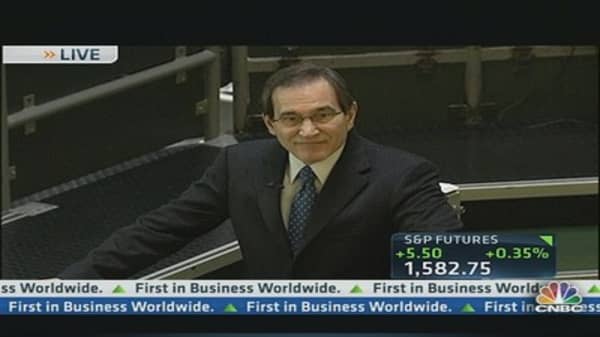Elsewhere in the economy, U.S. worker productivity barely grew from January through March after shrinking in the final three months of 2012. Weak productivity growth could prompt employers to hire more if consumers and businesses continue to increase spending.
The Labor Department says productivity rose at a seasonally adjusted annual rate of 0.7 percent in the first quarter, after shrinking 1.7 percent in the previous quarter.
Labor costs increased at a seasonally adjusted annual rate of 0.5 percent, below the fourth quarter's 4.4 percent gain.
Productivity is the amount of output per hour of work. It increased because output rose at a faster pace than hours worked.
Productivity has been under 1 percent since 2010 and well below the long-run trend of 2.2 percent growth a year dating back to 1947.
Finally, the March trade deficit fell more than expected, to $38.83 billion.
The trade deficit gap dropped as imports recorded their biggest decline since 2009, the latest sign of slowing domestic demand.
The Commerce Department said on Thursday the trade gap narrowed 11.0 percent to $38.8 billion - the second smallest since January 2010.
February's shortfall on the trade balance was revised to $43.6 billion from the previously reported $43.0 billion.
Economists polled by Reuters had expected the trade deficit to fall to $42.0 billion in March.
In March, the inflation-adjusted trade deficit narrowed to $44.4 billion from $47.8 billion in February. Trade weighed on first-quarter growth, cutting half a percentage point off gross domestic product.
The economy grew at a 2.5 percent annual rate in the first three months of the year and the smaller-than-expected trade gap could cause the government to revise higher this estimate.
The smaller trade gap in February reflected a 2.8 percent fall in imports of goods and services to $223.1 billion.
The percentage drop was the biggest since February 2009. The decline in imports of goods was almost broad based, adding to signs of sluggish domestic demand already flagged by weak retail sales and manufacturing data.
In March, exports of goods and services slipped 0.9 percent to $184.3 billion. Exports have been one of the bright spots in the economy, but are being crimped by a slowing global economy, which is hurting manufacturing.
A recent strengthening of the U.S. dollar, even though the Federal Reserve has firmly remained on its ultra-easy monetary path, is also taking the edge off export growth.
The dollar gained about 1.5 percent on a trade-weighted basis so far this year.
The three-month moving average of the trade deficit, which irons out month-to-to month volatility, edged up to $42.3 billion in the three months to March from $42.1 billion in the prior period.
U.S. exports to the 27-nation European Union rose 14.4 percent in March to $22.9 billion. Exports to the EU in the first three months of 2013 were down 8.0 percent compared to the same period in 2012.
Exports to the United Kingdom fell. Exports to China, which have been growing more slowly than in recent years, rose 1.4 percent in March.
China has been one of the fastest growing markets for U.S. goods, and exports to that country were up 4.3 percent for the first three months of 2013.
Imports from China fell 16.5 percent to $27.3 billion in March, pushing down the contentious U.S. trade deficit with China to $17.9 billion, the lowest since March 2010, from $23.4 billion in February.
-Reuters contributed to this report.




